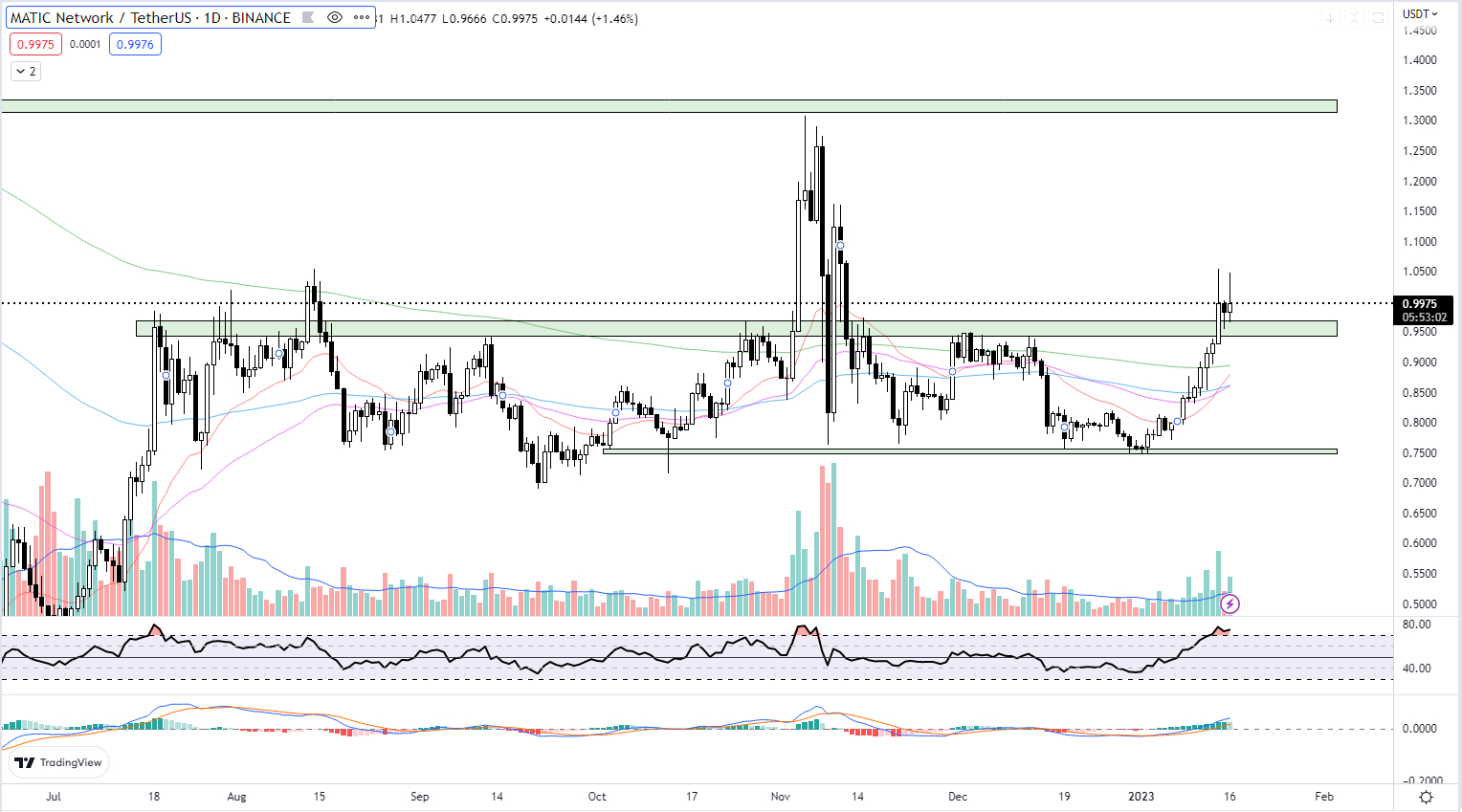How Polygon Hard Fork Will Boost Network Performance and MATIC Price

The Polygon PoS chain is preparing for a significant upgrade on Jan. 17, through a hard fork aimed at improving performance and predictability. The proposed changes include reducing gas spikes and addressing chain reorganization issues that have been identified by the community and the Polygon team as priorities for the network’s development.
Besides the fork, Polygon (MATIC) has had an otherwise impressive start to the new year as well, with a series of high-profile partnerships and launches with massive names like Disney and Reddit, as well as the launch of its web3-focused incubator with Mastercard.
The MATIC token is currently up 14.12% in the last seven days and is up 1.4% over the past 24 hours as the wider crypto market rally stalls for the time being.
Polygon zkEVM: Now with more throughput and less latency. But how?
— Polygon (@0xPolygon) January 13, 2023
Recursion makes proofs smaller. Aggregation makes them correct. Batches of proofs are also 150% larger. pic.twitter.com/3Hi9H2uasT
Polygon (MATIC) Hard Fork Details
The changes proposed by the hard fork aim to reduce the severity of gas spikes and address chain reorganization inefficiencies in an effort to reduce time to finality (the amount of time it takes for a transaction to be considered final and irreversible on the blockchain).
The first proposed upgrade aims to reduce gas spikes by changing the BaseFeeChangeDenominator from 8 to 16. This will help smooth out the increase/decrease rate in the base fee (the minimum fee for block inclusion) when the gas exceeds or falls below the target gas limits in a block.
The reasoning behind this change is that when the chain experiences high demand, the base gas fee experiences exponential spikes, which are not normal or good during surges in demand on any blockchain protocol. So, by increasing the denominator from 8 to 16, the growth curve can be flattened, resulting in a more seamless experience when interacting with the chain.
The second proposed upgrade addresses chain reorganizations (reorgs) by decreasing the sprint length from 64 to 16 blocks.
What’s a sprint and how does this impact the network?
When validators produce blocks, they do so in a sequence called a “sprint”. The sprint length refers to the number of blocks produced during a single sprint. By reducing the sprint length, the time a validator continuously produces blocks decreases, which in turn decreases the chances of a secondary or tertiary validator (who hasn’t discovered the primary) kicking in to produce blocks, resulting in fewer reorganizations (“reorgs”) overall.
This means a single block producer will produce blocks continuously for a much shorter time (~32 sec) than the current (~128 seconds). This will decrease the depth of reorgs, making the chain more predictable.
What’s a reorganization?
A reorganization, or “reorg” is a change to the blockchain’s history. It happens when a different chain that has more accumulated proof of work than the current chain is added to the blockchain.
In a blockchain network, validators work to maintain the integrity of the chain by reaching consensus on the ordering of transactions. In a PoS staking protocol chain like Polygon, validators “stake” a certain amount of the native token to participate in the consensus process. In the event that validators come to a disagreement on the ordering of transactions, it can lead to a split in the chain, with different validators working on different versions of the chain.
When this happens, the network will then “reorganize” itself to follow the chain with the most accumulated proof of work.Reorgs can happen for different reasons, such as a validator producing blocks on an old version of the chain, or a bug in the protocol which causes a chain split.
They can cause confusion and unpredictability for users and developers, which is why the Polygon team is proposing changes to the sprint length, in an effort to decrease the depth of reorgs and make the chain more predictable.
By implementing these changes, the Polygon PoS chain hopes to improve performance and predictability for users, validators, and developers.
How will the hard fork impact MATIC’s price?
In short, this hard fork is a major milestone in the development of Polygon and MATIC; it has the potential to boost network performance significantly and increase its popularity among users and developers alike. In turn, this could lead to a surge in MATIC’s price as demand for the token increases.
If this event excites investors as much as other news from other projects in the space, we could see major price moves for MATIC in the coming days. However, if the crypto market rally continues to lose momentum and potential buyers have already priced in this news, it’s possible that MATIC’s price may not benefit from the fork immediately.
Regardless, from a long-term fundamentals perspective, it’s clear that this hard fork will bring a lot of value to MATIC and the Polygon network, paving the way for more developments in the future.
Polygon (MATIC) Technical Analysis and Price Prediction
In terms of technicals, MATIC’s current price is pushing up against the $1 mark as bulls attempt to break this major psychological resistance mark. The Relative Strength Index (RSI) is at 57.32, showing that MATIC is in the “neutral” territory and not overbought or oversold. The next support down is in the $0.9418 to $0.9683 range, while the next resistance if the price breaks above $1 is between $1.31 to $1.33
The Moving Average Convergence Divergence (MACD) is showing a bullish potential, while the Ichimoku Base Line is 0.9013; the Volume Weighted Moving Average (20) is at 0.8750; and the Hull Moving Average (9) is 1.0161. All of these indicate that MATIC is on an overall upward trend and could potentially benefit from the upcoming hard fork.
https://www.twitter.com/sennet_ai/status/1615016402607382532As always, investors should do their own research before investing any money into cryptocurrency or other digital assets and take risk management measures such as setting stop losses.
Overall, MATIC has a lot of potential to increase in value over the long-term as the Polygon team continues to roll out new features and updates that improve network performance. While it is impossible to tell exactly how much MATIC’s price will increase as a result of this event, long-term investors should keep an eye on any developments and changes that occur prior to and during the fork.




